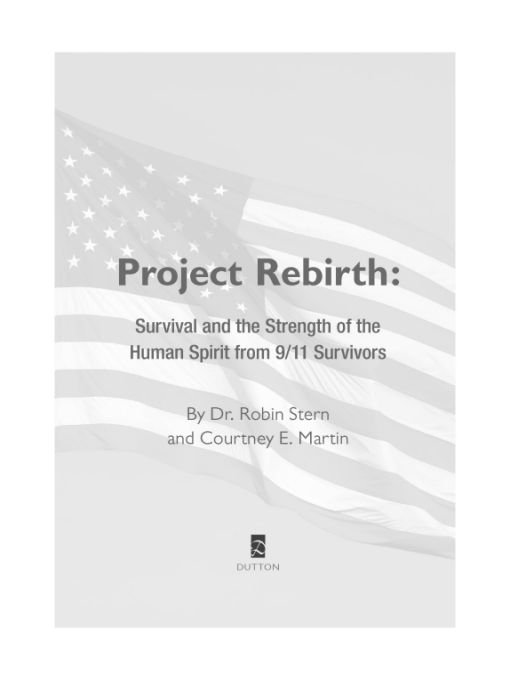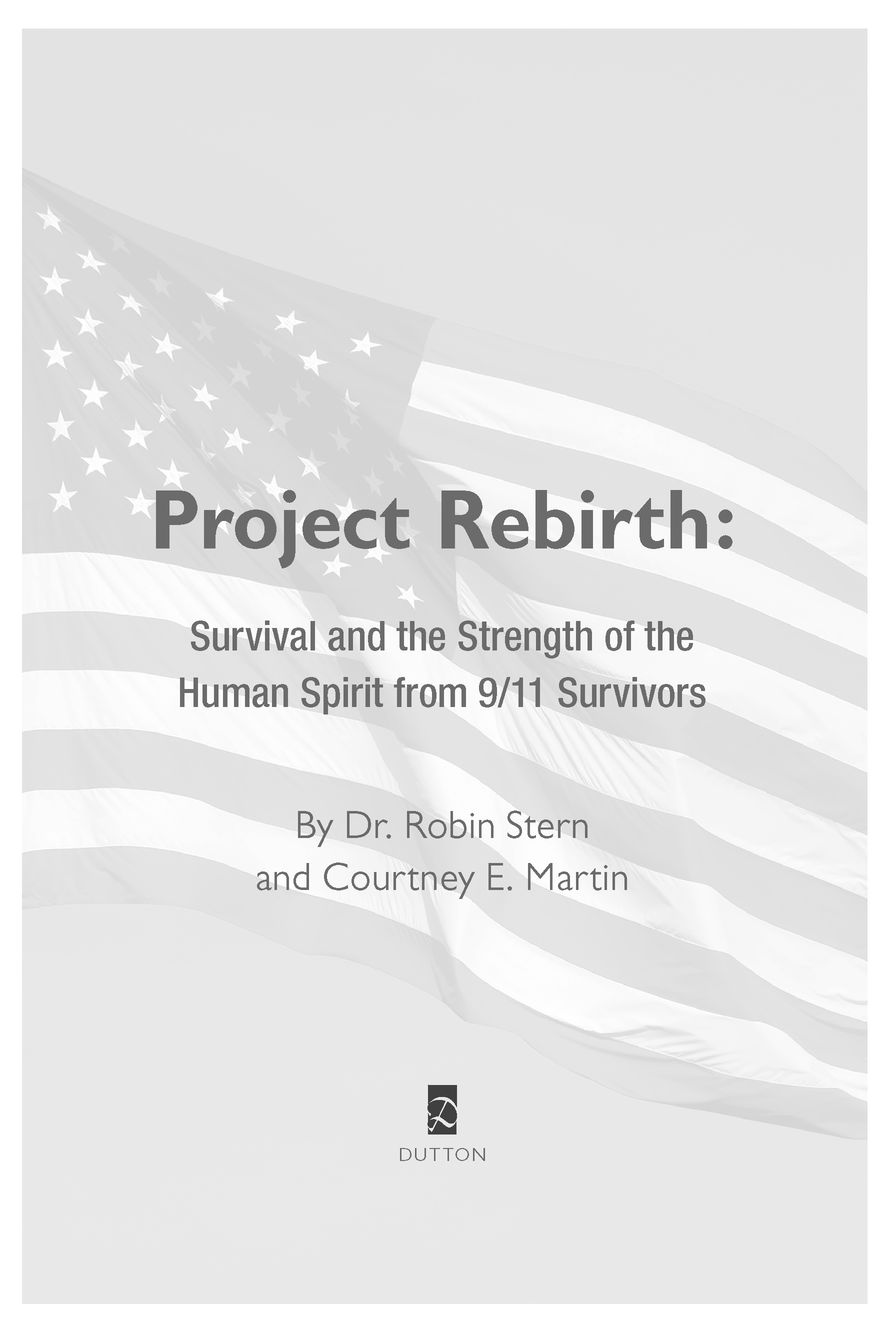Project Rebirth
Authors: Dr. Robin Stern



Table of Contents
Â
Â
Â
DUTTON
Published by Penguin Group (USA) Inc.
375 Hudson Street, New York, New York 10014, U.S.A.
Penguin Group (Canada), 90 Eglinton Avenue East, Suite 700, Toronto, Ontario M4P 2Y3, Canada (a division of Pearson Penguin Canada Inc.); Penguin Books Ltd, 80 Strand, London WC2R 0RL, England; Penguin Ireland, 25 St Stephen's Green, Dublin 2, Ireland (a division of Penguin Books Ltd); Penguin Group (Australia), 250 Camberwell Road, Camberwell, Victoria 3124, Australia (a division of Pearson Australia Group Pty Ltd); Penguin Books India Pvt Ltd, 11 Community Centre, Panchsheel Park, New Delhiâ110 017, India; Penguin Group (NZ), 67 Apollo Drive, Rosedale, North Shore 0632, New Zealand (a division of Pearson New Zealand Ltd); Penguin Books (South Africa) (Pty) Ltd, 24 Sturdee Avenue, Rosebank, Johannesburg 2196, South Africa
Â
Penguin Books Ltd, Registered Offices: 80 Strand, London WC2R 0RL, England
Â
Published by Dutton, a member of Penguin Group (USA) Inc.
Â
First printing, August 2011
Â
Copyright © 2011 by Robin Stern and Courtney E. MartinAll rights reserved
Â
 REGISTERED TRADEMARKâMARCA REGISTRADA
REGISTERED TRADEMARKâMARCA REGISTRADAÂ
LIBRARY OF CONGRESS CATALOGING-IN-PUBLICATION DATA
has been applied for.
Â
ISBN : 978-1-101-54348-1
Â
Â
Without limiting the rights under copyright reserved above, no part of this publication may be reproduced, stored in or introduced into a retrieval system, or transmitted, in any form, or by any means (electronic, mechanical, photocopying, recording, or otherwise), without the prior written permission of both the copyright owner and the above publisher of this book.
Â
The scanning, uploading, and distribution of this book via the Internet or via any other means without the permission of the publisher is illegal and punishable by law. Please purchase only authorized electronic editions, and do not participate in or encourage electronic piracy of copyrighted materials. Your support of the author's rights is appreciated.
Â
While the author has made every effort to provide accurate telephone numbers and Internet addresses at the time of publication, neither the publisher nor the author assumes any responsibility for errors, or for changes that occur after publication. Further, the publisher does not have any control over and does not assume any responsibility for author or third-party Web sites or their content.
We dedicate this book to all those who cared for the survivors
of the tragedy on September 11, 2001, including the emergency
workers, therapists, healers, educators, doctors, nurses, spiritual
leaders, and, of course, their families and friends.
Their rebirth is in no small part your legacy as well.
of the tragedy on September 11, 2001, including the emergency
workers, therapists, healers, educators, doctors, nurses, spiritual
leaders, and, of course, their families and friends.
Their rebirth is in no small part your legacy as well.
Introduction
C
onstruction workers in hard hats and steel-toed boots mill around the new shipment of steel, the steam from their coffee hanging in the early morning air around Ground Zero. A trailer door swings open and an architect walks out, rolled-up plans in one hand, iPhone in the other. He looks on as a group of workers weld giant metal skeletons together, sparks flying past ladders and giant spools of cable and tarps covering slats of wood.
onstruction workers in hard hats and steel-toed boots mill around the new shipment of steel, the steam from their coffee hanging in the early morning air around Ground Zero. A trailer door swings open and an architect walks out, rolled-up plans in one hand, iPhone in the other. He looks on as a group of workers weld giant metal skeletons together, sparks flying past ladders and giant spools of cable and tarps covering slats of wood.
This is what it looks like to physically rebuild after devastation.
But what does it look like to emotionally and spiritually rebuild? This was the question that preoccupied usâa journalist and a psychoanalystâas we mined the lives of those who had been directly affected by the tragic events of September 11, 2001. We wanted to understand how ordinary people recover from grief, dust off the ashes of devastation, make sense of injustice and just plain bad luck, and emerge new, different, maybe even more whole.
We were not aiming for pat lessons. Too much has already been written that tries to reduce what happened on that fateful day into feel-good sound bites, political propaganda, or ratings-hyping melodrama. September 11th, like every historic moment, has been shaped and shifted, prodded and poked, adopted and adapted for various purposes over the past ten years. Most often, this work has been done with good intentions, but too much of the time, the true depth of the physical, emotional, and sometimes spiritual transformations that were rooted in that day's tragic events were lost.
There are such layers to the story of September 11th and its survivors, such nuances, such paradox. There is heroism and cowardice, nurturance and violence, anger and loveâthe whole panoply of human emotions circulating around this one day of unimaginable loss. Only that greatest and most difficult teacher of all, time, could really offer us the insights that we needed to do justice to these eight stories. It has now been ten full years since we first saw that indelible image of a Boeing 757 crashing into the North Tower of the World Trade Center, unbelievable as that is.
In those ten years, so much has happened. Technologically, culturally, and politically, we live in a truly new worldâone where disasters often play out online before anyone thinks to turn on a television, as they did on September 11th. There are cottage industries and whole branches of the government devoted to fighting the kind of threat we faced on September 11th. Even our language is differentâ“terrorism” has become a household word, something that could slip off the tongue of any ten-year-old in this nation. We watch revolutions and natural disasters play out on Twitter and send donations via text messageâall of which would have been inconceivable in the fateful fall of 2001.
But this book is not about technological or cultural shifts, nor is it about the analysis of national security advisers or international development experts. This book is not about politics or media or even the controversy that has surrounded the revisioning of Ground Zero or the creation of the September 11th Museum. This book is about the expertise and experiences of regular people. It is about Nick, Brian, Charles, Larry, Tim, Joe, Debbie, and Tanyaâeight studies in grief and resilience, loss and progress, sadness and transformation.
These lessons, after all, are most commonly culled from extraordinary circumstances, but their roots are universal. We all lose. We all grieve. We are all compelled to recover. For most of us, this experience occurs as part of life's natural, but inevitable, sadnessâa mother passing away from breast cancer, a life partner breaking one's heart by leaving for someone else, a friend struck by a heart attack despite seeming healthy. Though these circumstances are statistically ordinary, they are no less than deeply painful, leaving us grappling for wisdom and hope amid the sudden sense of foreign and consuming darkness.
But the extraordinary, too, is becoming more ordinary. Sudden disasters, like the one that struck America on September 11, 2001, are increasingly common because of global terrorism and climate change. “Where were you the day Kennedy was assassinated?” has become “Where were you the day the earthquake devastated Haiti? Where were you the day Katrina decimated New Orleans? Where were you when the World Trade towers and the Pentagon were hit?” In our increasingly insecure world, we are all subject to disaster and the collective project of reconstituting our communities, not to mention our worldview, afterward.
We were both in New York on September 11th. Robin, who has had her own psychoanalytic practice for thirty years, was on her way to see some patients that morning (eventually, she would counsel many clients directly affected by September 11th). Courtney was still asleep in her Barnard College dorm when the first plane hit the towers.
Robin's first thoughts, upon finding out about the terrorist attacks, were of her two children, Scott and Melissa, and her husband, Frank.
Were they safe? How could she immediately get to them?
Courtney's first thoughts were also of her familyâher parents so far away in Colorado Springs, her brother even farther in San Francisco. These questions quickly migrated to the future.
What did this all mean about her senior year, her future beyond college, the country's future?
Were they safe? How could she immediately get to them?
Courtney's first thoughts were also of her familyâher parents so far away in Colorado Springs, her brother even farther in San Francisco. These questions quickly migrated to the future.
What did this all mean about her senior year, her future beyond college, the country's future?
Robin's family and Courtney's dreams were safe, although forever changed by that horrible day. In the years that followed, we would become writing partners, but more than that, dear friends. When
Project Rebirth
came about, we jumped at the chance to work together, especially with such historic and profound stories as those found in this book. Courtney brings her journalistic training to the page, and Robin brings her vast experience as a clinician to help to present the grieving process in a new way. We both strongly believe that stories are tools of transformationâCourtney's usually live on the page and Robin's, more often, in the safe haven of her clinical practiceâand that is also why the format of this book was so appealing to us.
Project Rebirth
came about, we jumped at the chance to work together, especially with such historic and profound stories as those found in this book. Courtney brings her journalistic training to the page, and Robin brings her vast experience as a clinician to help to present the grieving process in a new way. We both strongly believe that stories are tools of transformationâCourtney's usually live on the page and Robin's, more often, in the safe haven of her clinical practiceâand that is also why the format of this book was so appealing to us.
In this book, we have brought both of our sensibilities and areas of expertise to bear, and we hope it makes for an approachable, layered, and inspiring read. Having the opportunity to delve into these stories, discuss them over countless lunches and coffees, laugh and cry together, and ask the subjects, ourselves, and each other so many big questions has been a gift of indescribable proportions. We hope the reverence we have for these people's lives is reflected in the book that you are about to experience.
As explained above, this book is not about politics. This book is about the personal. It is about the livesâlogistical, emotional, unique, and inspiringâthat are shattered by moments like 8:46 A.M., September 11, 2001, and then put back together during the years that followed. It is also not a book about psychology, per se. Though Robin is a psychoanalyst by training, she's more committed to practical lessons than abstract theory. Theory isn't supple and nuanced enough, in our view, to truly wrap itself around the breadth and depth of these stories. As sociologist Kai T. Erikson wrote of survivors whom he profiled, “People like that have been the victims of so many different forces outside their control that one hesitates to imprison them again between the cold parentheses of a theory.”
Other books
Talking Heads by John Domini
Clash of Civilizations Over an Elevator in Piazza Vittorio by Amara Lakhous
Stories of Faith and Courage From World War II by Larkin Spivey
A Season of Love by Amy Clipston
Fábulas morales by Félix María Samaniego
Ruddy Gore by Kerry Greenwood
Impetus by Sullivan, Scott M
OUR LAST NIGHT: an edge of your seat ghost story thriller by ADAMS, TAYLOR
Cash Money (Bad Money #4) by Ali Parker
